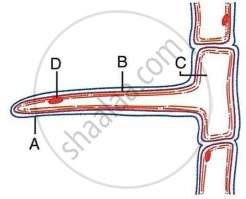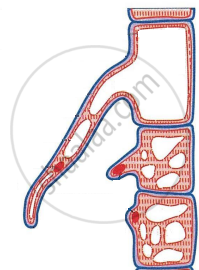Advertisements
Advertisements
Question
The diagram below represents a layer of epidermal cells showing fully grown root hair. Study the diagram and answer the questions that follow:

- Name the parts labelled A, B, C and D.
- The root hair cell is in a turgid state. Name and explain the process that caused this state.
- Mention one distinct difference between the parts labelled A and B.
- Draw a diagram of the above root hair cell as it would appear when a concentrated solution of fertiliser is added near it.
Solution
- A: Cell wall
B: Cell membrane
C: Cytoplasm
D: Nucleus - Endosrosis: The turgor pressure is produced when water from the ground enters the root hair and turns it turgid.
- Whereas the cell membrane of a root hair is semi-permeable and does not enable large dissolved salt molecules to pass through, the cell wall of a root hair is freely permeable and lets both salt and water flow through.

APPEARS IN
RELATED QUESTIONS
Cell wall is ______ but plasma membrane is ______.
______ refers to the membrane which allows passage of certain substances more readily than others.
For which of the following reason root cap has no function in water absorption?
Arrange and rewrite the terms in the group in the correct order to be in a logical sequence beginning with the term that is underlined:
Xylem, Soil water, Cortical cells, Root hair.
Mention two adaptations in roots for absorption of water from the soil.
Mention one characteristic of roots for absorbing water from the soil.
Which of the following is a living, semi-permeable membrane?
